Piggy and the Eternal City:
Science Fiction as Testing Ground for New Management Theory
John F. Keane
Bradford School of Management, ENG
Introduction
The speculative nature of the genre makes social settings provided by science fiction a fertile metaphorical testing ground for new management concepts. Science fiction's need to maintain internal consistency, or “the willing suspension of disbelief,” reinforces this claim. If the “environment” is adequately cogent, new perspectives on the relevant concept can emerge from such an approach.
In certain respects, this approach has been pre-empted by management researchers who examine organizations using metaphors (Clark and Salaman, 1996; Alvesson, 1993). Broekstra has examined organizational theories derived from the “new management” as metaphorical terms that can illuminate organizational research (Broekstra, 1996). However, there are important differences between this work and the method employed in this article.
Instead of merely “metaphorizing” the organization with a given theoretical approach, the present author seeks to link both organization and theory within a common metaphor. This approach “tests” the theory as a metaphor “practiced” within the wider metaphorical environment provided by the literary setting. This practical “testing” of metaphor has led the present author to term this approach “praxiphorical” analysis. The presence or absence of particular conditions in the metaphorical environment allows the researcher to infer ideal conditions for applying a concept. A fantastic metaphorical environment can help to explore the paradigm underlying the concept. Discontinuities between the theory in ideal and metaphorical “practice” can question its validity. This article has pursued all these approaches.
The article uses two classic science fiction novels to explore two concepts from the new management:
- William Golding's Lord of the Flies—The dissipative structures model devised by Ilya Prigogine.
- Arthur C. Clarke's The City and the Stars—The autopoietic concept devised by Humberto Maturana and Francisco Varela.
The social landscape of each novel has sufficient internal consistency to act as a viable model in testing the concepts. Both novels also elaborate each concept. This permits comparison with the management literature and development of new perspectives.
DISSIPATIVE STRUCTURES MODEL
This model is the most fully developed and respected in the physical sciences. Its creator, the Nobel Prize-winning chemist Ilya Prigogine, heads a research team based in Brussels researching self-organization in physical and chemical systems. The theory in outline is relatively simple, and uses thermodynamic principles to emphasize the role of chance in system development.
FAR-FROM-EQUILIBRIUM STATES
Systems in a state of equilibrium are featureless and chaotic. They have a maximum number of possible arrangements of molecular particles. No effect-producing differences are discernible anywhere.
Far-from-equilibrium systems are the opposite of this state. Living organisms and social organizations are good examples. They are not “finished” forms, but remain continually open to the outside world and dynamically active. This openness and activity allows far-fromequilibrium structures to escape from entropy and spontaneously generate new levels of order.
The export of internal entropy
For order to emerge in far-from-equilibrium systems, energy from the exterior must compensate for energy lost through internal processes.
Davies uses the example of a pendulum to show how far-fromequilibrium structures use external energy to achieve a new organizational structure (Davies, 1987: 84).
If a pendulum has no friction to dissipate its energy, it will continue to describe the same path, maintaining the same form, indefinitely (Figure 1).
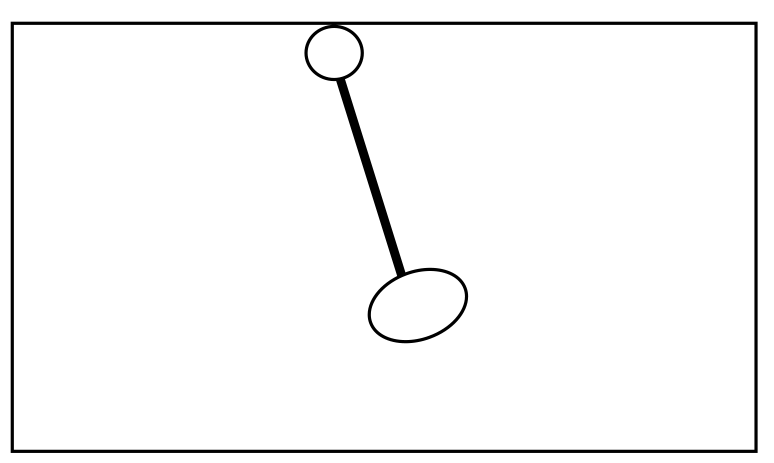
Figure 1
When the pendulum's motion is subjected to friction, the pendulum loses its form and grinds to a halt. The energy of the system has been dissipated by friction, or internal entropy production (Figure 2).
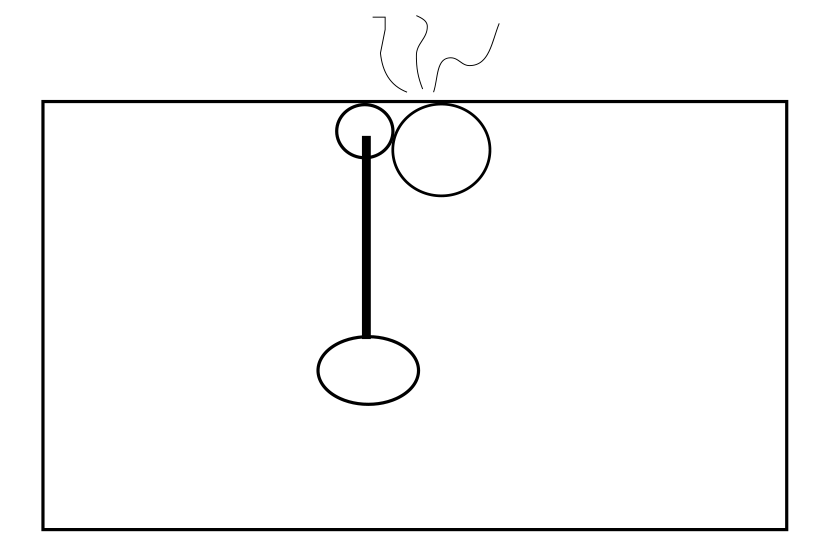
Figure 2
In a system open to the exterior, the pendulum will lose its existing form via friction while assuming another driven by energy from the exterior. Energy input must always exceed entropy production for new order to emerge. This is the first condition for self-organization. The system minimizes entropy production, spontaneously generating a new structural order without compromising the laws of thermodynamics (Figure 3). These structures have been called “dissipative structures” because they are defined by the dissipative flows and reactions characteristic of farfrom-equilibrium activity.
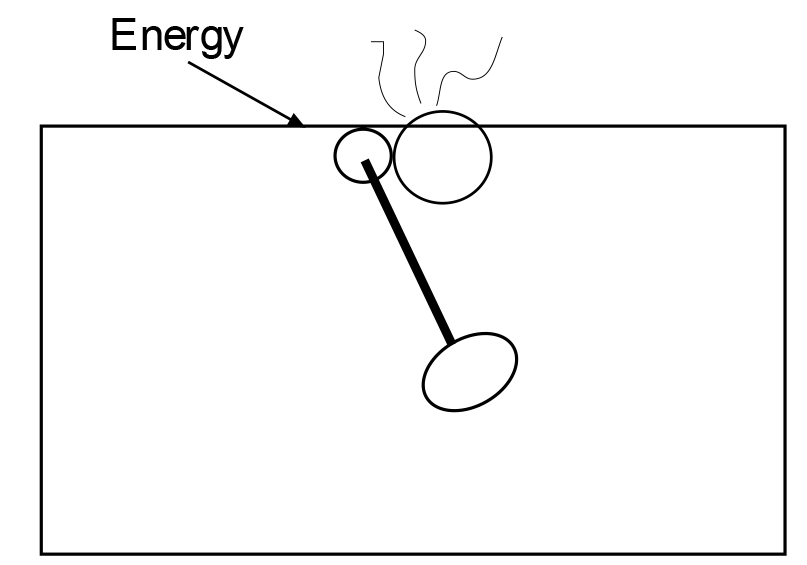
Figure 3
Non-linear interaction mechanisms
Compensation of entropy produced by energy gained from the exterior is the first precondition for far-from-equilibrium systems to produce selforganization. The second is the presence of non-linear interaction mechanisms between the microscopic elements of the system. These arise naturally in far-from-equilibrium processes (Prigogine and Stengers, 1984: 140-53).
Linear relationships between elements are so called because they can be described with a straight line. A good example would be the relationship between oranges and their price (Coveney and Highfield, 1995: 57-8). Five oranges cost five times more than one orange. Ten oranges cost ten times more. This directly proportionate relationship between two quantities defines linear relationships. Because the interaction between elements is consistently additive, long-term predictions of their behavior are possible.
But if two oranges are free for every twelve bought, and six for every eighteen, the relationship can longer be described using a straight line. This is a simple example of a non-linear relationship. The relationship between variables is disproportionate. Feedback results from non-linear processes, as process outcomes trigger additional changes that are impossible to predict.
Prigogine uses similar non-linear processes such as auto- or crosscatalytic reactions to explain chemical self-organization. Here, the product of a chemical reaction is involved in its own synthesis. Because of their extreme sensitivity to initial conditions, all mathematical descriptions used to predict these reactions are inadequate. An initial description of the behavior of all variables accurate to 100,000 decimal places is still inadequate to describe their interactions. Non-linear processes could theoretically be accurately described, were sufficiently accurate mathematical descriptions of initial conditions available. Since they are not, however, complex non-linear processes remain unpredictable (Davies, 1987: 23-5). They are their own best description. As Kelly (1994: 15) describes non-linearity:
2+2 = apples
The unpredictable nature of non-linear processes produces “fluctuations,” or deviations from the average values maintaining the system's steady state. These are of central importance to the phenomena of selforganization. Because of fluctuations, the evolution of a system containing non-linear mechanisms is not uniquely determined by the equations governing the interacting variables. Chance exercises an influence on the system's historical development. Fluctuations are also called “bifurcations” or “bifurcation points.”
ORDER-THROUGH-FLUCTUATIONS
If the system's original trajectory prior to a fluctuation was stable, the effect of the fluctuation will be damped and the system will return to it. This process is shown in Figure 4.
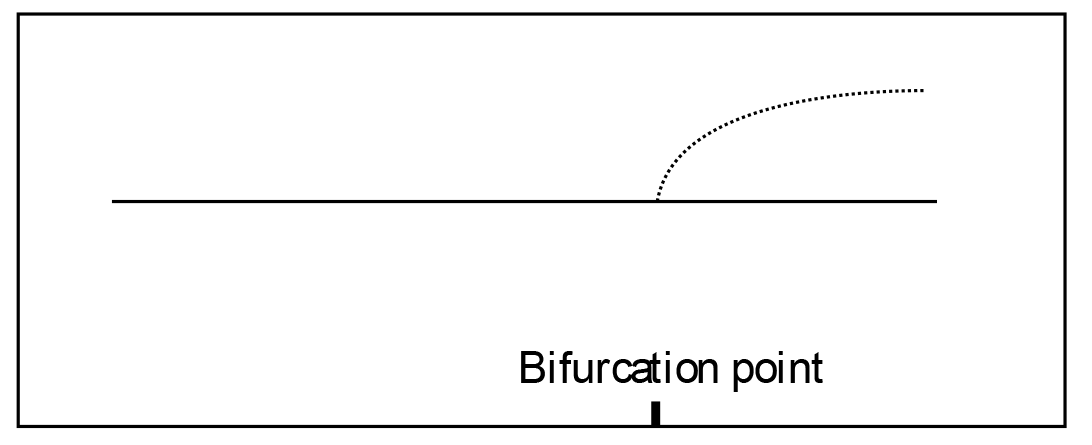
Figure 4 The solid line shows the system’s trajectory. The dotted line shows a fluctuation, or “choice” for the system.
But if the system's original trajectory were unstable, the system will be driven down a new bifurcation branch toward a completely unpredicted solution. This process is shown in Figure 5.
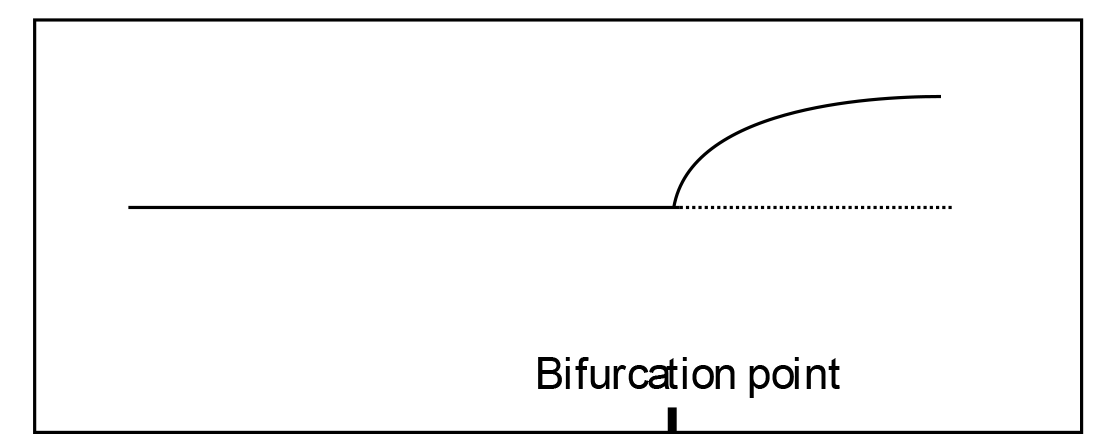
Figure 5 The solid line shows the system's actual trajectory before and after a fluctuation. The dotted line shows the hypothetical course of the system's initial trajectory after being driven off course by a chance fluctuation, or “choice” for the system.
The “history” of the system depends on which fluctuations occur. Each system has a unique history depending on its environment and the chance decisions it follows during its development. The system has unusual adaptive potential. Far-from-equilibrium systems have high sensitivity to external conditions unthinkable in equilibrium systems. They can adapt to subtle changes in external conditions through assisted bifurcation. Any state of the system will only remain stable if it adapts to environmental conditions. The sophisticated communications of dissipative structures assist this adaptive capacity. Dissipative structures behave coherently, as though each molecule were “informed” about the state of the whole system (Prigogine and Stengers, 1984: 160-67; Davies, 1987: 86).
The entire evolutionary process of such a structure over time is shown in Figure 6.
Biological order through fluctuations
A dissipative structure (like all non-linear systems) can at best be statistically described, yet is so sensitive to initial starting conditions that such descriptions cannot preclude the possible emergence of chance behavior and fluctuations. It is not necessarily possible to deduce the historical development of a non-linear system from the equations governing the interacting variables. Each system will have its own unique history and potential set of outcomes. As a system develops, chance and determinism interact, the deterministic equations governing steady state conditions As the chemical system is pushed further from equilibrium, the straight lines showing the system's steady state reach various thresholds of stability. Fluctuations then occur. The solid lines show the system's actual trajectories. The dotted lines show potential courses ignored by the system after a series of fluctuations, or random “choices.” The birfurcation points create a unique “history” for the system as it develops over time. Both chance and environmental influences determine the “choices” made.
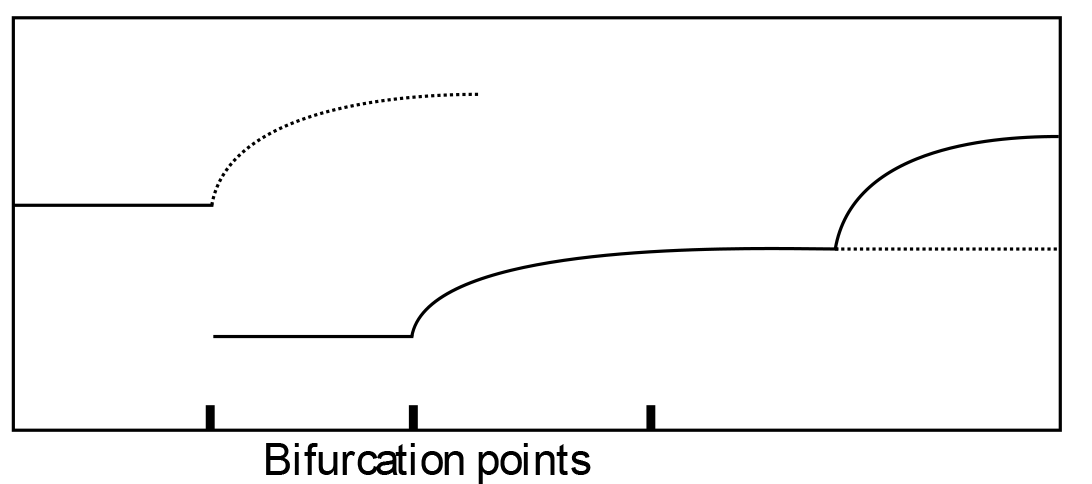
Figure 6 As the chemical system is pushed further from equilibrium, the straight lines showing the system’s steady state reach various thresholds of stability. Fluctuations then occur. The solid lines show the system’s actual trajectories. The dotted lines show potential courses ignored by the system after a series of fluctuations, or random “choices.” The birfurcation points create a unique “history” for the system as it develops over time. Both chance and environmental influences determine the “choices” made.
damping or amplifying random fluctuations. Auto-catalytic feedback is the major influence on this amplification process.
“Order by fluctuation” is a paradigm that can be applied equally well to the study of systems that are described in terms of basic units having themselves an internal structure and containing mechanisms governing their interaction with the environment and other elements of the system (Allen and Sanglier, 1978: 266).
Biological systems frequently self-organize in a similar manner to the order-through-fluctuations model characteristic of far-from-equilibrium chemical systems. For example, termite nests begin when a single termite leaves some of its attractant hormone on the ground. This is the equivalent of a chance fluctuation. The hormone attracts other termites. These termites leave more hormone and also drop earth on to the spot. The fluctuation is amplified into a new termite mound by an accretive, non-linear process (Prigogine and Stengers, 1984). This process corresponds to one stage of a bifurcation tree, with a single fluctuation being amplified all the way into a new state. Nonetheless, it intimates how social selforganization might proceed.
Perturbations, or fluctuations caused by physical stress, can also arise in biological structures. For example, the directionality of snail shells (that is, their tendency to right- or left-handedness) is thought to have originally arisen from a minute perturbation created by universal weak force at an early stage of their development (Stewart and Golubitsky, 1993: 176-82). This perturbation was then amplified via genetic replication. Most bifurcations at a biological level arise from the tendency of organic systems to oscillate or buckle, so losing their original single-state symmetry, when subject to stressing physical forces. Other examples include the natural tendency for animal locomotion methods to break symmetry when stressed (Stewart and Golubitsky, 1993: 214-18).
THE MANAGEMENT LITERATURE ON ORDER-THROUGH-FLUCTUATIONS
The management literature describes spontaneous group change in the following terms. If the environment stresses a social system, it drives it far from thermodynamic equilibrium (Smith and Gemmill, 1991, 1985). With sufficient energy from the exterior, it may then fluctuate as a whole into a new trajectory better suited to the environment (Leifer, 1989). A system can co-evolve with the environment in this manner, achieving new, adaptive order by means of spontaneous fluctuations (Takeuchi and Nonaka, 1986; Stacey, 1991).
LORD OF THE FLIES AS A MODEL OF ORDER-THROUGH-FLUCTUATIONS
William Golding's famous novel Lord of the Flies describes group transformation in similar terms to the management literature. The following “order-through-fluctuations” concepts can be found in Golding's novel:
- External pressure driving a social system far-from-equilibrium into non-linear, unpredictable behavior.
- A far-from-equilibrium social system temporarily fluctuating into a new trajectory better adapted to the external environment.
- A far-from-equilibrium social system bifurcating into a new, better adapted trajectory on a permanent basis.
The novel's plot is simple. A number of boys from a public (fee-paying) school crash land on a desert island. At first, they try to construct a democratic culture, with some success. This culture is associated with various objects and symbols such as a conch shell, a signal fire, and a pair of spectacles. However, the necessity of survival in a hostile environment makes it hard to sustain this culture. The social system developed around the conch is put under increasing pressure. This stress drives the group towards a new trajectory better suited to the environment. This is the culture of hunting, violence, and authority exemplified by Jack Merridew. As the pressure increases, the occasional fluctuations towards this new trajectory become more frequent. The group eventually adopts the new trajectory. Representatives of the old conch culture—Ralph and Piggy—become outcasts.
Prigogine's concept of order-through-fluctuations can largely explain this sequence of events. Prigogine argues that a system can achieve a new order—a new trajectory—if it acquires sufficient energy from the environment to compensate for the energy it naturally loses through entropy.
At first, the group only assumes the new trajectory on an occasional basis. The original trajectory is still stable enough to “damp” the fluctuation. Permanent assumption of the new trajectory is associated with a heavy storm, Simon's murder and the group's collective encounter with the beast. This emotional and experiential input helps to create a new social order comparatively well adapted to the island environment. Figure 7 shows the sequence of events.
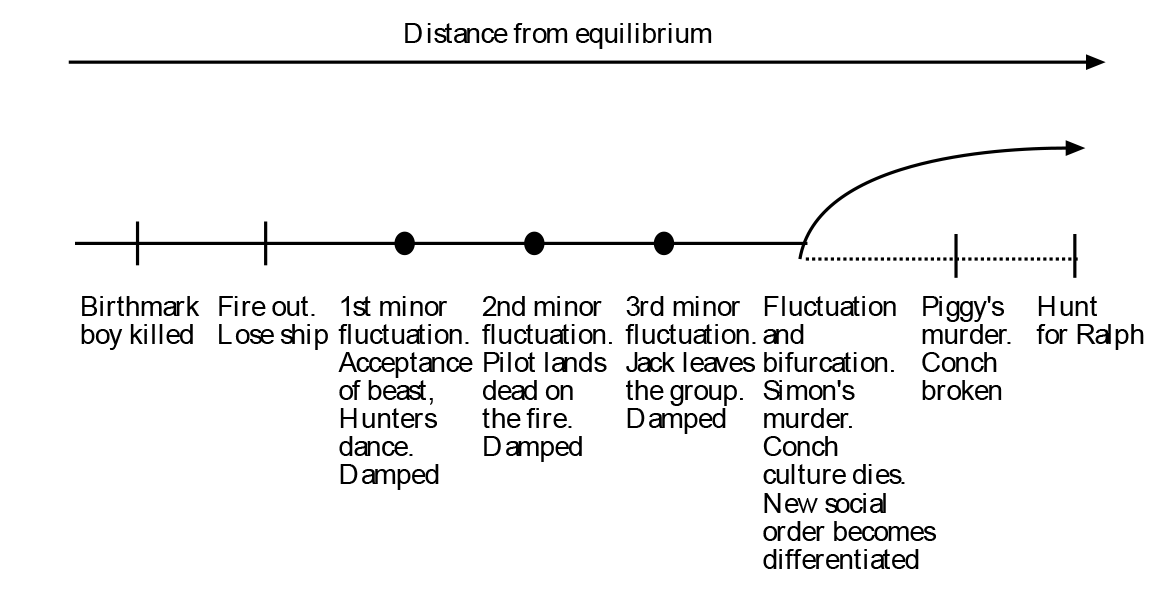
Figure 7 Main events in Lord of the Flies described by the order-through-fluctuations model
The new order arising from the major fluctuation is another mode of organization, not mere chaos. Jack cleverly hunts Ralph by sweeping the island with a line of hunters. Each member passes an ululation along the line. This alerts the whole group to the fugitive's presence. Indeed, the social order generated by the fluctuation is probably more highly developed than that of the initial trajectory. By definition, it is better adapted to the environment.
It is difficult to doubt that the novel uses Prigogine's concept to explain social change. Internal consistency allows comparison of a process governed by metaphorical conditions with those that prevail in the management literature.
Minor oscillations in the group's structure take a variety of forms. One of these is the conflict between Jack and Ralph. The group's attention focuses alternately on these two, and accepts the leadership of whoever prevails:
“That's right. Keep Piggy out of danger.” “Have some sense. What can Piggy do with only one eye?” The rest of the boys were looking from Jack to Ralph, curiously. (Golding, 1961: 97)
The management literature has overlooked the importance of leadership during transformation through fluctuations. Yet here, the group's attention focuses on two protagonists. Whoever prevails dominates the group.
Finding a unit of analysis has always been problematic in applying Prigogine's concepts to social adaptation. “Energy” is a consistent unit in physical systems. It is not consistent in social systems. The energy that a social group requires to achieve new order has never been properly defined in the management literature. The novel infers that extreme or unusual emotional experiences such as storms can provide the energy influx for a group to achieve a new mode of organization.
In the novel, physical objects are important in maintaining group cohesion. The destruction of the symbols associated with the conch culture leads to feedback, reinforcing the new trajectory. Roger smashing the conch is the most obvious example of this. However, the new group trajectory also uses physical symbols. Most obvious of these are the coloured clays that the choir use for hunting.
According to Prigogine, natural manifestations of order-throughfluctuations such as the Brusselator are characterized by unified activity (Prigogine and Stengers, 1984):
Remarkably, all the molecules in the Brusselator seem able to “communicate” with each other over vast distances, all knowing when to turn blue, and when to turn red. The “tick” of this chemical clock as it rolls around the limit-cycle moat is a function only of certain physical properties of the Brusselator. (Coveney and Highfield, 1995: 162)
The excitations of heart muscles or the brain have similar operating principles (Goodwin, 1994: 56-62).
Golding similarly describes oscillations in the group's initial trajectory. For example, the climactic dance that leads to the bifurcation point is a unified, rhythmic process, like the Brusselator:
The movement became regular while the chant lost its first superficial excitement and began to beat like a steady pulse. Roger ceased to be a pig and became a hunter, so that the centre of the ring yawned emptily. Some of the littluns started a ring of their own; and the complementary circles went round and round as though repetition would achieve safety of itself. There was the throb and stamp of a single organism. (Golding, 1961: 144-5).
Piggy, Simon and Ralph are seldom included in these group fluctuations/oscillations. The new social order that finally emerges from them actively persecutes these three boys.
Pressure from the environment imposes unity on the group even before the major bifurcation. After the beast has taken possession of the mountain, the boys prepare to confront it as a single organic entity:
The bright morning was full of threats and the circle began to change. It faced out, rather than in, and the spears of sharpened wood were like a fence. (Golding, 1961: 96)
Prigogine claims that a physical structure will act with systemic unity to achieve adaptive order if provided with sufficient energy. The literary model links external pressure, energy influx, group unity and new organizational trajectories in an identical manner. External pressure on the group forms a continual backdrop in the novel. Natural phenomena provide an energy influx, though this also represents external stress. Under these influences, the group acts as a unity when oscillating into a new trajectory.
The novel also provides psychological perspectives on the process of group fluctuation. Loss of self is synonymous with boys who follow the new trajectory. Ralph, who stands between hunting and tradition, experiences this loss as “a curtain” in his mind that obscures his ideas (Golding, 1961: 162). The face paint adopted by the hunters is “liberation into savagery” (ibid.:164). When Jack first regards his painted face, he sees “an awesome stranger” (ibid.: 61). The frenetic dances that actually lead to the new trajectory involve a loss of self (ibid.: 144-5). Freud referred to such feelings of ego loss as jouissance: an ecstatic overflow of oceanic feelings (Freud, 1991: 251-2). This psychological state is synonymous with spontaneous group transformation in the novel. It is also associated with the same process in other literature (Euripedes, 1973).
Although the model of order-through-fluctuations explains most of what transpires, there are important exceptions. The fact that some group members resist the bifurcation presents interesting difficulties. The management literature does not confront this possibility. The fate of those who resist the fluctuation in the novel is harsh. Such treatment might well characterize the treatment of non-conformists in conventional organizations.
Further, the transformation of the group occurs via a sequence of minor fluctuations or oscillations eventually culminating in birfurcation. The process is not instantaneous but incremental. In the early stages of the process, Jack's group is often autonomous. However, this autonomous behavior never confronts the prevailing culture. It is, indeed, subcultural. Eventually, as the social system moves far enough from equilibrium, the subculture assumes dominance. This has important implications for the study of subcultures in organizations.
AUTOPOIESIS IN THE PHYSICAL SCIENCES AND SYSTEMS THEORY
This concept derives from the biological sciences. Its main characteristic is a rejection of the possibility of objectivity. Organisms inevitably perceive external threats or opportunities in self-referential terms.
Varela, Maturana and Uribe devised the original model in 1974 (Varela, Maturana and Uribe, 1974). The theory created a new definition of life based on the ability of a system to reproduce its own structural network rather than merely reproduce. This led to a definition of the autopoietic system as a: network of productions of components that a) through their interactions recursively regenerate the network of productions that produced them, and b) realize this network as a unity by constituting and specifying its boundaries in the space in which they exist, is a autopoietic system. (Maturana, 1980: 52-3; see also Maturana and Varela, 1980)
network of productions of components that a) through their interactions recursively regenerate the network of productions that produced them, and b) realize this network as a unity by constituting and specifying its boundaries in the space in which they exist, is a autopoietic system. (Maturana, 1980: 52–3; see also Maturana and Varela, 1980)
An autopoietic system is necessarily autonomous and self-referential. Having defined its own borders from within, it achieves autopoietic “take-off” or radical autonomy, which lasts indefinitely or until external perturbations exceed the capacity of its self-organized responses.
AUTOPOIESIS IN THE MANAGEMENT LITERATURE
Luhmann was one of the first researchers to apply the concept to the social sciences (Luhmann, 1984, 1986: 172-92). His work stressed the self-referentiality of social systems. In Luhmann's view, communications constitute social systems. They are recursively reproduced by the communications network itself. Language is ephemeral in this process. The maintenance of social systems requires self-referential production.
In his development of an epistemology of law, Teubner referred extensively to Luhmann's work. For Teubner, the network of legal communications refers only to itself as it develops, not to the external world of persons (Teubner, 1988, 1989: 727-59). It derives meaning from itself. External agents are redefined by the legal communicative network as features of itself.
Kauffman translates autopoiesis as infusing organizations with a dynamic conservatism. The self-organizing features of changeability and adaptiveness are used for the sole end of preserving
the existence of organizations (Kauffman, 1976). Bureaucracy never dies, but spontaneously pursues whatever courses will regenerate its system of organization.
Jessop applied autopoietical concepts to the study of political institutions and their interrelationships. His view of an autopoietic institution is one characterized by radical autonomy (Jessop, 1990). Such an institution continually defines its own boundaries and creates its own rules of governance. Jessop used the concept of structural coupling to describe the mutual relationship between co-evolving institutions in the same social eco-culture. The state, itself characterized by autopoietic principles, can exert only the blind, limited influence on other organizations in the same society characteristic of structural coupling.
Morgan uses autopoiesis as a metaphor to think of organizations as closed, self-referential, and autonomous (Morgan, 1986). Certain aspects of organizational behavior emerged as features of this metaphor. Organizations viewed the external environment as projections of themselves, reflexively protected their identity in relation to the wider world and spontaneously evolved in relation to these concepts. Morgan considered that these features of organizations were potentially nonadaptive.
Kickert suggests that the concept can reverse the current view of the relationship between organizations and environments. This intriguing interpretation of the relationship has received limited attention in organizational science. Kickert also argues that institutions are inevitably highly autonomous. This is because of the reasons cited by Hayek: complete social control by a single institutional body such as government is impossible (Kickert, 1993: 276). In an era when top-down governmental control is being steadily ceded in favor of self-governance, Kickert argues that autopoiesis is an important step to understanding institutional autonomy in adaptation and co-evolution with other institutions.
Nonaka and Takeuchi describe the autonomy of Japanese creative firms in autopoietical terms. Autonomous groups and individuals define their own task boundaries in the same way that autopoietic systems define their operating systems from within. Self-organizing teams governed by autopoietic, self-regulating principles are presented in this work as vital to knowledge creation (Takeuchi and Nonaka, 1995).
The autopoietic concept has redefined the role of information technology in commercial enterprise. The recursive nature of autopoiesis makes it a useful theoretical model for structuring software to act as a selforganizing medium for enterprise evolution (Whitaker, 1993; Winograd and Flores, 1986).
THE CITY OF DIASPAR CONSIDERED AS AUTOPOIETIC SYSTEM
The background to Arthur C. Clarke's The City and the Stars is Diaspar, the last city on earth. It has survived the ravages of time for a billion years. The plot concerns Alvin, a Unique who has no fear of the external world. Unlike all other Diaspar inhabitants, Alvin yearns to leave the city.
The following autopoietic concepts can be found in Clarke's novel:
- A closed, self-referential system evolving without reference to the external environment.
- An autonomous system that obeys its own law of motion.
- An autonomous system that generates the means of its own production.
- A recursive relationship between the system's parts and the whole.
- Spontaneous self-protection of the system's self-creating capacities.
- A self-model of the system that prevents it being overwhelmed by its own complexity.
As Diaspar is first described, we see it conforms perfectly to Varela and Maturana's model of an autopoietic system. This is remarkable when one considers that the novel predates autopoietic science by more than two decades.
Diaspar shields itself from the outside world. Completely autonomous, it has achieved autopoietic take-off from its environment. This results in a state of radical autonomy in which the city remains unaffected by time:
Men had built cities before, but never a city such as this. Some had lasted for centuries, some for millennia, before Time had swept away even their names. Diaspar alone had challenged Eternity, defending itself and all it sheltered against the slow attrition of the ages, the ravages of decay, and the corruption of rust. (Clarke, 1960: 7)
The inhabitants of Diaspar have an autopoietic consciousness. The perimeters of the autopoietic system delimit their understanding. They have no knowledge of the environment beyond:
They had forgotten much, but they did not know it. They were as perfectly fitted to their environment as it was to them—for both had been designed together. What was beyond the walls of the city was no concern of theirs; it was something that had been shut out of their minds. (Clarke, 1960: 7)
All inhabitants are terrified of the external environment. Millennia of autopoietic detachment have made them incapable of functioning outside the city. Even the thought of what lies beyond incapacitates them:
She could not follow him. She had realized the meaning of that remote circle of light from which the wind blew for ever into Diaspar. Behind Alystra was the known world, full of wonder yet empty of surprise, drifting like a brilliant but closed bubble down the river of time. Ahead, separated from her by no more than the span of a few footsteps, was the empty wilderness—the world of the desert—the world of the Invaders. (Clarke, 1960: 39)
Diaspar's inhabitants have no need for the external environment. The city can sustain itself and its inhabitants indefinitely:
The men who built this city, and designed the society that went with it, were lords of mind as well as of matter. They put everything that the human race would ever need inside these walls—and then made sure that we would never leave them. (Clarke, 1960: 31-2).
An autopoietic system must have a recursive relationship between the parts and the whole. This enables the system to adapt spontaneously to external perturbation:
Consequently every change in any of the components must affect the interactions among all other components in such a way as to yield a new counter-balancing response of the unity as a whole towards the maintenance of its integrity. The whole responds through a structural adaptation, i.e., by further deforming the field of its components. The behavior of components is thus affected (or even determined) by such deformations, and so on. The whole and the parts reciprocally influence and determine each other. (Zeleny, 1980: 20)
The city's operating network, the Central Computer, links the parts and the whole in a recursive relationship:
The Council ruled Diaspar, but the Council itself could be overridden by a superior power—the all-but-infinite intellect of the Central Computer. It was difficult to think of the Central Computer as a living entity, localized in a single spot, though actually it was the sum total of all the machines in Diaspar. (Clarke, 1960: 71)
If any part of this structural description alters, the city spontaneously reshapes itself to accommodate:
Diaspar might be held in perpetual stasis by its eternity circuits, frozen for ever according to the pattern in the memory cells. But that pattern could itself be altered, and the city would then change with it. It would be possible to redesign a section of the outer wall so that it contained a doorway, feed this pattern into the monitors, and let the city reshape itself to the new conception. (Clarke, 1960: 73-4)
However, Diaspar recursively informs the Central Computer of the need to change any of its parts.
In autopoietic systems, the self-producing features of the structural network maintain all activities. Consequently, certain aspects of the structural whole must be inviolate to changes by components from within.
The Jester Khedron, designed to provide Diaspar with a random element, can subvert the governing structure. He achieves this by manipulating the city's self-representation. Yet, as in the literature, certain aspects of Diaspar's overall structural network are inviolable. Without those aspects of the network that create and maintain components, the city would lose all self-definition. Autopoietic networks inevitably defend their own structure in this way. Since the relational network created Khedron, it protects itself by recursively limiting his power to alter its definitive features:
Khedron must have a profound understanding of the machines and powers that ruled the city, and could make them obey his will in ways which no one else could do. Presumably there must be some overriding control which prevented any too ambitious Jester from causing permanent and irreparable damage to the complex structure of Diaspar. (Clarke, 1960: 58)
Safeguards restrain the Jester's intrinsic nature to alter the structural network:
Khedron was content with the order of things as it was. True, he might upset that order from time to time—but only by a little. He was a critic, not a revolutionary. (Clarke, 1960: 61)
Khedron was the only other person in the city who could be called eccentric—and even his eccentricity had been planned by the designers of Diaspar. Long ago it had been discovered that without some crime or disorder, Utopia soon became unbearably dull (Clarke, 1960: 55).
The Central Computer resembles the State in Jessop's writings (Jessop, 1990). Jessop argues that complex autopoietic systems require a simplified self-representation to prevent their own complexities overwhelming them. The State, for example, is an autopoietic selfrepresentation of the political system that allows it to function. Without such a self-representation, the system would become lost in its own complexities. The Central Computer serves a similar function for Diaspar. It represents the system to itself, allowing recursive adaptation and development.
An important distinction between Diaspar and autopoiesis in the management literature involves the separation of structural network and self-representation in the latter. In Diaspar, both functions reside in the Central Computer. The network is the representation.
There are other important differences between the autopoietic system in the novel and the management literature.
Most management writers on autopoiesis stress the importance of an operating code for the system. Jessop, for example, claims that a public-private code governs the State. It is difficult to detect any code in the literary model, however. Self-perpetuation is its sole reason for existing.
Morgan argues that autopoietic organizations see the external environment as a feature of themselves. They supposedly overemphasize their own importance. However, Diaspar has completely turned away from the outside world. The legends of Diaspar claim that mankind made an ancient pact with its conquerors, the Invaders, after a cosmic war. This allowed humans to live unmolested so as long as they remained on Earth. The City's self-image is one of minimal importance in the environment.
The City and the Stars has most value for management scholars in describing how to maintain an autopoietic organization. Ironically, the ethos of the novel is in fact anti-autopoietic. Clarke infers that such radical autopoiesis is a less than ideal social state. Alvin, the hero, leaves Diaspar in fruitful pursuit of wider experience.
For those with a more positive view of autopoietic organization, the novel raises several important questions:
- Does the autopoietic organization require a random element to prevent stagnation? The system must have the ability to adapt internally, even in the absence of external knowledge or interest. An autonomous law of internal motion is an obligatory feature of autopoietic status. A social system might require a subject to initiate this movement.
- What dissonant elements can the autopoietic organization allow? In the literary example, the system is reflexively intolerant of all nonassimilable elements. Allowing a subject with an imperfectly assimilated character into the system does it irreparable damage.
- To what extent can management abbreviate the system's selfrepresentation, so that it retains a functional role? The success of the city as an autopoietic system depends on the perfect accuracy of its self-representation. Further, the representation can instantly shape the system. Contemporary social systems can never attain this consistency of self-representation. The Central Computer does not need to abbreviate its self-representation to itself since it is the selfrepresentation. The human actors in a social system can never match this level of social comprehension. A single consciousness can never apprehend a social totality with which it experiences a recursive relationship (Hayek, 1989: 79). Indeed, Jessop argues that some simplification is necessary for a self-representation to aid institutional system functioning. The question remains to what extent the system should undergo symbolic simplification. The literary model implies that the maximum complexity permitted is preferable. In the management literature on autopoiesis, a lively debate involves the degree to which the self-organizing capacities of social systems subsume human agents (Robb, 1989; Hejl, 1984). Diaspar's self-representation is clearly “suprahuman.” However, its reliance on the reflexive capacity of technology to represent the whole system infers the capacity of information technology to create an adaptive self-representation on and through which human agents can act.
- One of the most fruitful applications of autopoiesis in enterprise studies is as a model for the configuration of information technology (Whitaker, 1993). The novel has praxiphorical value in this regard, since it describes an autopoietic system where information technology is indispensible. Whitaker has developed a hypertextual group interface enabling all members of an enterprise to access and accrete knowledge at a single IT surface. Various criteria structure this knowledge,such as level of consensus and operational context. Diaspar's model of itself can facilitate instant recursive change and representation. As an example of an autopoietic operating system, the praxiphorical model is characterized by speed, accuracy, and ubiquity. By these means, the system's human agents can manage and use its suprahuman complexity. Experts in the autopoietic use of IT should theoretically aspire to these operating characteristics.
- To what extent can participants subvert the structural network? The literary example allows the core, self-reproducing features of the network to be protected while still permitting the possibility of change from within. The minimum specifications required to retain autopoiesis are presented. Is autopoietic autonomy more complete the longer a system exists? In the literary example, the city acquires total autonomy by designing parts to fit the system. It achieves this ability only after a lengthy period of autopoietic autonomy. Self-design can only occur when the operating system subsumes all subsidiary elements.
- Do autopoietic organizations necessarily overemphasize their importance in the environment? In the novel, the city and its inhabitants have no stake in the environment at all.
CONCLUSION
The “praxiphorical” approach to examining management concepts developed in this paper has indicated that analyzing organizational concepts within a literary setting can illuminate them as practical applications. This transcends the typical use of metaphor in this context, which involves merely associating organizational processes with concepts derived from science or biology. Though this may reveal new aspects of organizational operation, it cannot intimate how the concepts might operate under extreme hypothetical conditions as part of a total “praxiphor.” This experimental capacity can only inhere to the “praxiphorical” approach developed here.
Certain practical guidelines for successfully approaching this type of analysis naturally emerged from the study. Where a management paradigm is present in a literary context, systemization of analytical (praxiphorical) method needs directing towards three goals:
- To isolate the effect of metaphorical conditions on the management paradigm.
- To compare the effect of metaphorical conditions surrounding the management paradigm with typical conditions.
- To isolate how the effects of metaphorical conditions illuminate the management paradigm.
If the literary context is sufficiently rich to achieve these goals, then a successful analysis is more likely to result. Finding a text that contains the relevant management concept also involves ensuring that it contains sufficient depth to allow rigorous examination in terms of the three criteria outlined above.
References
Allen, P.M. and Sanglier. M. (1978) “Dynamic models of urban growth”, Journal of Social and Biological Structures, 1: 265-80.
Alvesson, Mats (1993) “The play of metaphors”, in John Hassard and Martin Parker (eds) Postmodernism and Organizations, Wiltshire: Sage: 114-31.
Broekstra, Gerrit (1996) “The triune brain metaphor: the evolution of the living organization”, in David Grant and Cliff Oswick (eds) Metaphor and Organizations, Guildford: Sage.
Clark, T and Salaman, G. (1996) “Telling tales: management consultancy as the art of story telling”, in D. Grant, and C. Oswick, (eds) Metaphor and Organizations, Guildford, Sage: 166-84.
Clarke, Arthur C. (1960) The City and the Stars, London: Transworld.
Coveney, P. and Highfield, R. (1995) Frontiers of Complexity: The Search for Order in a Chaotic World, St. Ives: Faber and Faber.
Golding, William (1961) The Lord of the Flies, London: Penguin.
Davies, P.C.W. (1987) The Cosmic Blueprint, London: Heinemann.
Euripedes (1973) The Bacchae and other Plays, ed. and trans. Philip Vellacott, Harmondsworth: Penguin.
Freud, Sigmund (1991) “Civilization and its discontents”, in James Strachey (trans.) and A. Dickson (ed.), The Penguin Freud Library Volume 12, St Ives: Penguin: 233-40.
Goodwin, Brian (1994) How the Leopard Changed its Spots: The Evolution of Complexity, London: Weidenfeld and Nicholson.
Hayek, Friedrich A. (1989) The Fatal Conceit: The Errors of Socialism, London: Routledge.
Hejl, P. (1984) “Towards a theory of social systems: self-organization and self- maintenance, self-reference and syn-reference”, in H. Ulrich and Gilbert J.B. Probst (eds), Self-Organization and Management of Social Systems: Insights, Promises, Doubts, and Questions, Berlin: Springler-Verlag: 60-78.
Jessop, B. (1990) State Theory: Putting the Capitalist State in its Place, Cambridge: Polity Press.
Kaufman, H. (1976) Are Government Organizations Immortal?, Washington: Brookings Institution.
Kelly, K. (1994) Out of Control: The New Biology of Machines, Social Systems and the Economic World, Reading, MA: Addison-Wesley.
Kickert, W.J.M. (1993) “Autopoiesis and the science of administration: essence, sense and nonsense”, Organisation Studies, 14: 261-78.
Leifer, R. (1989) “Understanding organization transformation using a dissipative structure model”, Human Relations, 42 (10): 899-916.
Luhmann, N. (1984) Soziale Systeme, Frankfurt: Suhrkamp.
Luhmann, N. (1986) “The autopoiesis of social systems”, in F Geyer and J. van der Zouwen (eds), Cybernetic Paradoxes, London: Sage: 172-92.
Maturana, H.R. and Varela, FJ. (1980) Autopoiesis and Cognition: the Realisation of the Living, Boston: Reidel.
Maturana, Humberto R. (1980) “Autopoiesis: reproduction, heredity and evolution”, in Milan Zeleny (ed.), Autopoiesis, Dissipative Structures and Spontaneous Social Orders, Colorado: Westview: 45-79.
Morgan, G. (1986) Images of Organization, London: Sage.
Nonaka, I. and Takeuchi, H. (1995) The Knowledge-Creating Company, New York: Oxford University Press.
Prigogine, I. and Stengers, I. (1984) Order Out of Chaos: Man's New Dialogue with Nature, New York: Random House.
Robb, Fenton (1989) “The limits to human organization: the emergence of autopoietic systems”, in M.C. Jackson, P. Keys and S.A. Cropper (eds), Operational Research and the Social Sciences, London: Plenum: 247-51.
Smith, C. amd Gemmill, G. (1985) “A dissipative structure model of organization transformation”, Human Relations, 38: 751-66.
Smith, C. and Gemmill, G. (1991) “Change in the small group: a dissipative structure perspective”, Human Relations, 44: 497-716.
Stacey, R.D. (1991) The Chaos Frontier: Creative Strategic Control for Business, Oxford: Butterworth Heinemann.
Stewart, I. and Golubitsky, M. (1993) Fearful Symmetry: Is God a Geometer?, St Ives: Penguin.
Takeuchi, H. and Nonaka, I. (1986) “The new new product development game”, Harvard Business Review, Jan-Feb: 137-46.
Teubner, G. (1988) Autopoietic Law; a New Approach to Law and Society, Berlin: de Gruyter.
Teubner, G. (1989) “How the law thinks: towards a constructivist epistemology of law”, Law and Society, 23 (5): 727-59.
Varela, Francisco G., Maturana, Humberto H. and Uribe, R. (1974) “Autopoiesis: the organization of living systems, its characterization and a model”, in Bio Systems, 5.
Whitaker, R. (1993) “Interactional models for collective support systems: an application of autopoietic theory”, in R. Glanville and G. de Zeeuw (eds), Interactive Interfaces and Human Networks, Amsterdam: Thesis: 119-35.
Winograd, T. and Flores, F (1986) Understanding Computers and Cognition, Norwood: Ablex.
Zeleny, Milan (1980) “Autopoiesis: a paradigm lost?”, in Milan Zeleny (ed.), Autopoiesis, Dissipative Structures and Spontaneous Social Orders, Colorado: Westview: 3-33.